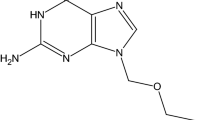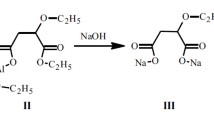Abstract
An efficient synthesis of poly-valent difluorinated zanamivir modified polymer as strong inhibitor of influenza virus was reported. Specifically, the mono difluorinated zanamivir with an azide linker was attached on alkynlated [poly (methyl vinyl ether-alt-maleic anhydride)] via “Click Chemistry” to afford polyvalent glycopolymer. The neuraminidase inhibition assay against H7N9 virus like particle showed an enhanced anti-influenza virus activity with IC50 value at least 1000 fold better than that of the difluorinated zanamivir monomer.
Access this chapter
Tax calculation will be finalised at checkout
Purchases are for personal use only
Similar content being viewed by others
References
National Health and Family Planning Commission of the People’s Republic of China, Reports of nationally notifiable infectious diseases. Available online: http://www.moh.gov.cn/jkj/s3578/201612/8a84c914186441d9a444e81751f58863.shtml
Itzstein MV et al (1993) Rational design of potent sialidase-based inhibitors of influenza virus replication. Nature 363(363):418–423
Wagner R, Matrosovich M, Klenk HD (2002) Functional balance between haemagglutinin and neuraminidase in influenza virus infections. Rev Med Virol 12(3):159–166
Hay AJ, Hayden FG (2013) Oseltamivir resistance during treatment of H7N9 infection. Lancet 381(9885):2230–2232
Kim JH et al (2013) Mechanism-based covalent neuraminidase inhibitors with broad-spectrum influenza antiviral activity. Science 340(6128):71–75
Das K et al (2010) Structures of influenza A proteins and insights into antiviral drug targets. Nat Struct Mol Biol 17(5):530–538
Lundquist JJ, Toone EJ (2002) The cluster glycoside effect. Chem Rev 102(2):555–578
Cecioni S, Imberty A, Vidal S (2015) Glycomimetics versus multivalent glycoconjugates for the design of high affinity lectin ligands. Chem Rev 115(1):525–561
Cheng CK et al (2014) From neuraminidase inhibitors to conjugates: a step towards better anti-influenza drugs? Future Med Chem 6(7):757–774
Weight AK et al (2011) Attaching zanamivir to a polymer markedly enhances its activity against drug-resistant strains of influenza a virus. J Pharm Sci 100(3):831–835
Haldar J et al (2010) Bifunctional polymeric inhibitors of human influenza A viruses. Pharm Res 27(2):259–263
Yang ZL, Zeng XF, Liu HP, Yu Q, Meng X, Yan ZL, Fan ZC, Xiao HX, Iyer SS, Yang Y, Yu P (2016) Tetrahedron Lett 57(24):2579–2582
Acknowledgements
This work was financially supported by the Natural Science Foundation of China (21402140, 21502139) and the International Science & Technology Cooperation Program of China (2013DFA31160). The authors are thankful to the Research Centre of Modern Analytical Technology, Tianjin University of Science and Technology for NMR measurements.
Author information
Authors and Affiliations
Corresponding author
Editor information
Editors and Affiliations
Rights and permissions
Copyright information
© 2018 Springer Nature Singapore Pte Ltd.
About this paper
Cite this paper
Liu, H., He, H., Yang, Z., Yu, P., Lu, K. (2018). Polyvalent Effect Enhances Anti-influenza Virus Activity. In: Liu, H., Song, C., Ram, A. (eds) Advances in Applied Biotechnology. ICAB 2016. Lecture Notes in Electrical Engineering, vol 444. Springer, Singapore. https://doi.org/10.1007/978-981-10-4801-2_89
Download citation
DOI: https://doi.org/10.1007/978-981-10-4801-2_89
Published:
Publisher Name: Springer, Singapore
Print ISBN: 978-981-10-4800-5
Online ISBN: 978-981-10-4801-2
eBook Packages: Chemistry and Materials ScienceChemistry and Material Science (R0)




